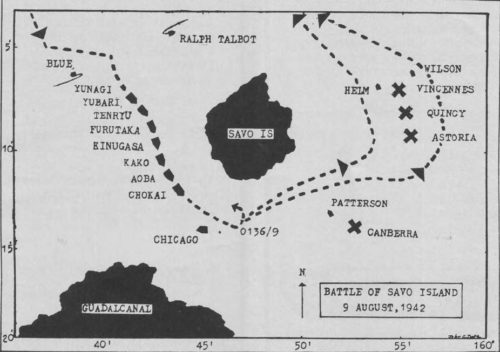- Author
- Date, John C., RANVR (Rtd)
- Subjects
- WWII operations, History - WW2
- Tags
-
- RAN Ships
- HMAS Canberra I
- Publication
- September 1989 edition of the Naval Historical Review (all rights reserved)
While Stutt’s report did have some discrepancies in that his message named:
‘three cruisers, three destroyers, two seaplane tenders or gunboats in Lat 0549S Lon 156.07E course 120° speed 15 knots’
when actually the composition between the two Japanese groups was five heavy cruisers, two light cruisers and one destroyer, nevertheless the Allies should have reacted more positively to Stutt’s report.

It appears to have been a great error of judgement that Turner and Crutchley were so quick to accept Stutt’s radio report of mentioning ‘two seaplane tenders or gunboats’ as meaning setting up a seaplane base at nearby Rekata Bay, thus not requiring immediate action, when the message in itself was indecisive. Certainly Turner did request further reconnaissance from Admiral McCain’s Catalina flying boats operating from nearby bases south of the Solomons which unfortunately was never executed and without any notification to that effect.
Mikawa after intercepting Stutt’s message, and anticipating surveillance had split his force to confuse further sightings with one part being sighted by a second Hudson A16-185 piloted by Sgt L. Milne. After landing and debriefing at 1404/8, this second report now identifying the force as:
‘two heavy cruisers, two light cruisers and an unidentified vessel …’ being mentioned in the MacArthur COMSOWESPAC Situation Report 330 of 8 August and giving the sighting time of 1101/8, was subsequently stated by Crutchley (OC Allied fleet ships) that he had the report in the afternoon.
As Captain Bonnot stated (4):
‘The records show that Stutt and Milne did a proper, professional job in reporting their sightings. In fact the entire 32 Squadron including the two Hudsons, received a ‘Letter of Commendation’ from Major General Kenny on MacArthur’s Staff in recognition of its excellent work in the Port Moresby area from 1 August, 1942 to 5 September, 1942.’ The reasons for the naval catastrophe must be re-evaluated and history rewritten to clear the Hudsons of any blame in the ensuing Savo Island Battle of 9 August, 1942.
(J.C.D. 1989)
BIBLIOGRAPHY:
- Samuel Eliot Morison: “History of United States Operations on WWII”, Little, Brown and Company. Boston, 1955. (1) page 25, (2) page 27
- Captain Emile L. Bonnot, USNR (Ret): “Were The Hudsons To Be Blamed For The Naval Disaster at Guadalcanal?”, Historian General Emeritus, Naval Order of the United States, 23 February, 1988. (3) -, (4) page 7.




